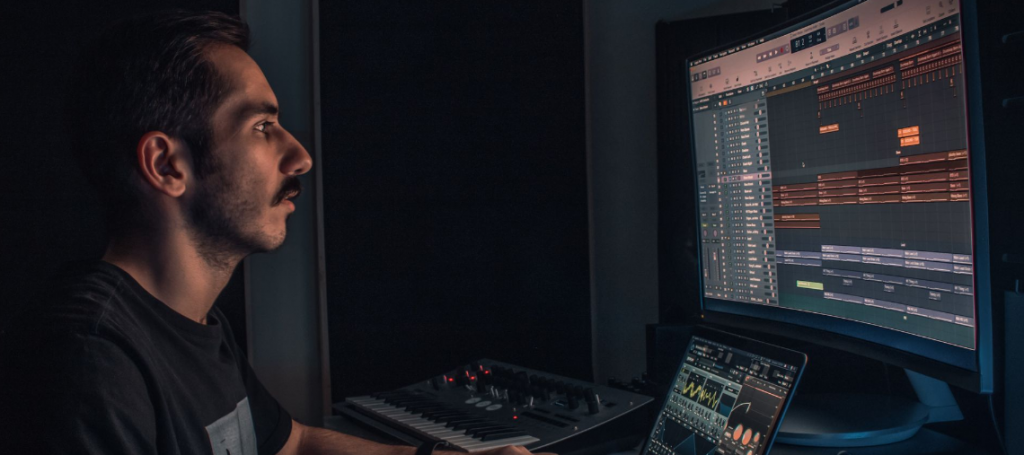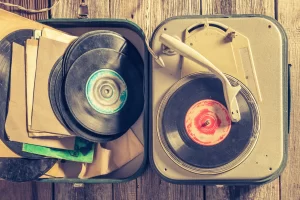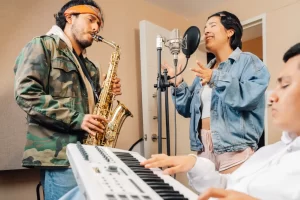It is not always easy to create original beats. Many producers learning the ropes of music production often have no idea how to produce beats on their own from scratch. They start their careers by creating simple beats through trial and error, and later move on to more complex tracks.
If you are just starting out, the concept may feel abstract and intimidating, and the process of beat-making – difficult and challenging.
Beat-making can take a minute, hours, or even days. But once you’re done making your beats and arranging them, your entire song will feel consistent and orchestrated.
Allow yourself to be creative and don’t approach beat-making thinking that you must follow a rigid step-by-step process. The steps we talk about here are not set in stone.
In this comprehensive guide, we tell you all you need to know about making a beat. You will learn:
● What a beat is
● What you need to create a beat
● A step-by-step rundown on the beat-making process, and
● Some expert-backed hacks that will show you how the pros do it.
Let’s roll.
What is a beat?
The meaning of music beats is subjective to the listener and the artist. For music lovers, a beat is simply a measurement of music to which they can dance and jam. But for music producers and artists, a beat is a building block for their compositions.
A beat is a steady pulse of music that lasts for a specific amount of time. Think of it as the rhythm you would tap your toes to when listening to music, or the numbers you would count when composing.
What makes a good beat?
A good beat can be considered one that has a strong, steady rhythm and good flow. A beat can also be considered as one that has both musical and rhythmic value—it could be about something in the lyrics, or it could just have an interesting rhythm to it.
The way your beat sounds when you hear it in your head will be different from how it’s written down on paper. Here is a good rule of thumb: The best beats are those that are simple on paper but complex when you hear them for the first time—this means that they have both musical and rhythmic value.
How to know if a composed beat is good?
A good beat can be difficult to identify, but there are some tell-tale signs that you may have composed a solid one:
● The instrument matches your desired melody
● It gets stuck in your head, and you may find yourself humming the melody or even singing it out loud.
● A catchy rhythm that makes you want to dance or move.
● You can visualize it as being a part of a natural progression in your music piece.
It’s also worth pointing out that finding the right beat is highly subjective. What sounds excellent to your trained ears may not sound as wonderful to others. But remember that only you know how it will make up your music and nobody else. Always go with your instincts.
Which tools do you need to make a beat?
We are living in a wonderful age. There are a plethora of tools and resources available to independent musicians and record producers who wish to compose their music. Music distribution services also make it possible to get your music out there quickly and easily.
But perhaps the most amazing thing is that anyone can write music, no matter how much money they have.
Here is a brief rundown on some of the best tools for making a beat:
DAW
A DAW, or digital audio workstation, is a piece of audio recording and editing software that serves as your studio. DAWs are essentially digital replicas of actual music recording studios. They have all of the equipment you need to make beats and record great music, including digital instruments, mixing boards, and multitrack recording.
The Best DAWs for Desktops:
● FL Studio. Available on Windows and macOS.
● Ableton Live. Available on Windows and macOS.
● Cubase. Available on Windows and macOS.
● GarageBand. Available on macOS. It’s free, but still punches way above its weight.
● BandLab. Cloud-based and free. Also available on iOS and Android.
The Best DAWs for mobile devices:
● Cubasis. Available on iOS and Android.
● FL Studio Mobile. Available on iOS and Android.
● GarageBand. Available on iOS. Android users get a similar alternative with the Walk Band.
● N-track. Available on iOS and Android.
● G-Stomper Producer. Available on Android.
If you have a full-featured DAW with various instruments and sounds baked into its programs, you can do away with the rest of the tools when making a beat. However, a lot of these tools are considered music essentials in the industry, and it wouldn’t hurt to take some time to get to know them.
MIDI controller
A MIDI controller is a device that lets you combine the sounds of various instruments into your music using your computer or another electronic music-making device. A MIDI controller allows you to create a wide range of sounds with a single device. Some controllers support up to 16 pads and are recognized by the majority of DAWs and soft synths.
Audio interface
Audio interfaces connect your computer to speakers, headphones, mixers, instruments, synths, samplers, and more. They help you convert audio signals (say, from your guitars and violins) into computer-processable data, allowing you to record and edit audio in DAWs.
Virtual instrument plug-ins
They produce sounds that can be used to create music. Samplers and synthesizers are the two main categories of virtual instruments you’ll use.
Samplers
Samplers are digital musical instruments that generate their sounds from recordings of actual instruments. Pianos, drums, guitars, basses, strings, etc. can all be types of sampled instruments.
Synthesizers
Synthesizers are electronic devices that let you modify various aspects of an audio signal. They can produce a wide range of sounds, from classic guitar riffs to distorted bass lines, and from percussive rhythms to complex vocal harmonies.
How to make a beat?
Now that you have a basic understanding of what tools you will need to make your beats, let’s dive into the process of making a beat.
1. Write down your tune
Before you load up the music production software of your choice, you should always take the time to put it down on paper. It may not be exactly as you hear it in your head, but it should be pretty close and give you a pretty solid jumping-off point.
2. Select your tempo
Tempo makes a song sound good or bad, depending on how it is done. It is important to know that the tempo of a song does not just depend on how fast the notes are played, but also on how long they are held. Tempo can be as low as 72 BPM or can go as high as 160 BPM. You should consider the following when selecting the tempo for your piece:
● The genre of music you want to produce.
● The type of beat you are producing.
● The mood and energy of your song.
● The kind of sound you intend to create with your beat.
Some artists tend to choose slower tempos, while others prefer faster ones. The tempo of your beat can affect the mood and the tone of your lyrics. The right tempo will help you to achieve the correct feel for the song and make it easier for people to sing along to it.
3. Select your instruments
There are a multitude of electronic instruments to choose from. You have to decide which types of beats you intend to create with which instruments. Some examples include: the synthesizer, drum machine, sampler, and mixer.
There are eight essential sounds for a beat.
● Kick drum
● Snare drum
● Clap
● Hi-hat
● Cymbals
● Tom Toms
● Synth bass
● Percussion
4. Create the base beat
Start with kicks and drums and place them as bars according to your musical notations. If you don’t like what you are hearing, you can always ditch your notes completely and start experimenting.
Make the beat count:
The first thing to ensure when making a beat is that it has a steady rhythm and is not too long or too short.
Apply a good tempo:
A good tempo will help you keep the beat going without making your listeners feel bored or impatient with the song. The tempo can be adjusted depending on what genre you are trying to create. A slow tempo can be used for ballads, while fast tempos can be used for dance tracks.
Add textures: Experiment with different types of kicks—like snares or bass kicks. You can also introduce different sounds to your kick drum—like claps or snares—to give your beat more texture.
Use different kinds of percussion instruments: As you play your beat, use different types of percussion instruments to create a variety of sounds. The type of percussion instrument that will bring out the most sound is the drum kit.
Create a basic rhythm pattern: A basic rhythm pattern introduces a song. It will be the same rhythmic pattern that repeats throughout the song. This is a crucial step in making the base beat because all your other instruments, such as strings, guitar, and drums, will be laid atop this.
Even if your sound isn’t quite there yet, it doesn’t mean you can’t come up with a killer beat. It only means you need to play some more with different rhythms and tempos to create variations and to find the beat that just “clicks”.
5. Create the bass line
A bass line is a fundamental part of any track. It is the foundation of a beat and gives it a rhythm and flow.
● A good beat needs to have a bass line that starts out soft, then builds up until it reaches its climax at the end.
● The best way to create a bass line is by using your ears. Listen to other songs and try to find patterns in their bass lines that you can use for your song.
● In order for your beat to sound good, you need to make sure that the bass line is layered with other instruments such as drums, guitars, or piano chords.
● You also want to make sure that there are breaks in between each set of notes so that they don’t blend too much or sound too repetitive.
6. Bring other virtual instruments into the mix
If you want to add more depth to your beat, try adding an instrument that’s not readily available in the beat-making software, such as a virtual instrument. There are many ways to add depth to your beats with virtual instruments. You can try adding:
● Synths
● Plucks
● Vocals
● Sound effects
But be careful not to overuse them, or they’ll start to feel muddled and take away from the quality of your beat.
7. Fine tune your beat
The beat you have now may be a solid one, but that doesn’t mean it can’t be better. Fine-tuning your beat may improve it drastically and may even give you some delightful beat variations that you can use later in a chord progression. Here are some ways you can fine tune your beat:
● Using a different instrument and find the same kind of sound.
● Keeping the same instrument but changing the octave.
● Using a different instrument on the same octave.
● Using an instrument that has no equal note in your scale, like a bass drum or a cymbal, and play it on every beat to create emphasis.
● Readjusting your beat so that there’s more time between each instrument.
In order to fine tune your beat, you should ideally focus on one sound at a time. You should also make sure that you do not make too many changes, or else you will run the risk of altering your beat entirely.
Pro-tips for beat-making
Now we look at some expert-backed advice for making beats.
Use a metronome
Many artists use a metronome to make sure they are playing at the right tempo and rhythm. It is important to have a metronome handy when you’re creating beats. Some artists use a pencil to record their beats as well. You can do the same by tapping on the pencil as you get a rhythm going, or by drawing circles or lines with the pencil.
Split your channels
There are two different types of people in this world: those who like melodies and those who like energy. And artists assign instruments to channels based on the genre of their music. This is called “splitting the channels”. The left channel will typically be more melodic and more laid-back, while the right channel will be more intense and aggressive.
Regardless of the science behind this, you should always split the channels—not just while making a beat, but during the entire process. When you split the channels, you have more precise control over things like panning, equalizing, stereo widening, etc. If you can adjust the volume, pan, and other settings of each instrument in your project, you’ll be able to achieve a more polished and professional sounding beat.
Vary your hi-hats
Hi-hats are little buggers that can leave your beat sounding uninteresting and flat. They are important sounds in house, DnB, and other dance music styles, but don’t fall into the compositional trap of layering a flat, even stream of hits over your backbeat. Artists get around this by changing the speed and timing of the notes. For example, you could turn down the strength of every other note to add emphasis on the on-beat or off-beat.
Velocity is another way artists manipulate their hi-hats. Velocity relates to the volume of the notes. Hi-hat notes are often created with the same sampled sound to keep consistency throughout the project, and will have the same velocity.
In general, higher velocity equals a louder instrument note; lower velocity equals a softer note. You could also take the time to make more complicated velocity curves and change the regularity of the notes, which would probably result in more interesting rhythms.
Use fewer sounds
Several top names make their beats sound more interesting by limiting the number of sounds that are used, such as bass, guitars, synths, etc. They tend to focus on one or two sounds rather than a myriad of different ones. One easy way to make your beats sound more captivating is by limiting the number of sounds that are used in your track. You can also try simplifying your drum pattern and changing your tempo.
Some more tips you probably didn’t think of:
● Get some good headphones with no noise cancellation.
● Make sure that you are listening to some reference music from the correct genre when trying out new beats.
● Always have a pen and paper handy when you are creating beats, or you will never remember anything you hear.
● Keep in mind that there are no rules when it comes to making beats, so do what feels right for you.
Wrapping up
Beat making is a skill that is often overlooked by many artists. This can be attributed to the fact that it is not as easy as it sounds. It requires a lot of practice and patience to make a killer beat. The steps outlined here are not set in stone. What works for one may not work for the other. However, the general process of making a beat remains the same. Build a strong foundation for your song with a great beat, and you will be on your way to composing a killer track.
Once you’ve created your music and want to distribute your releases on major platforms, you can sign up with Novecore for free. We’ll help you get your music on platforms such as Spotify, Apple Music, Deezer and SoundCloud.




